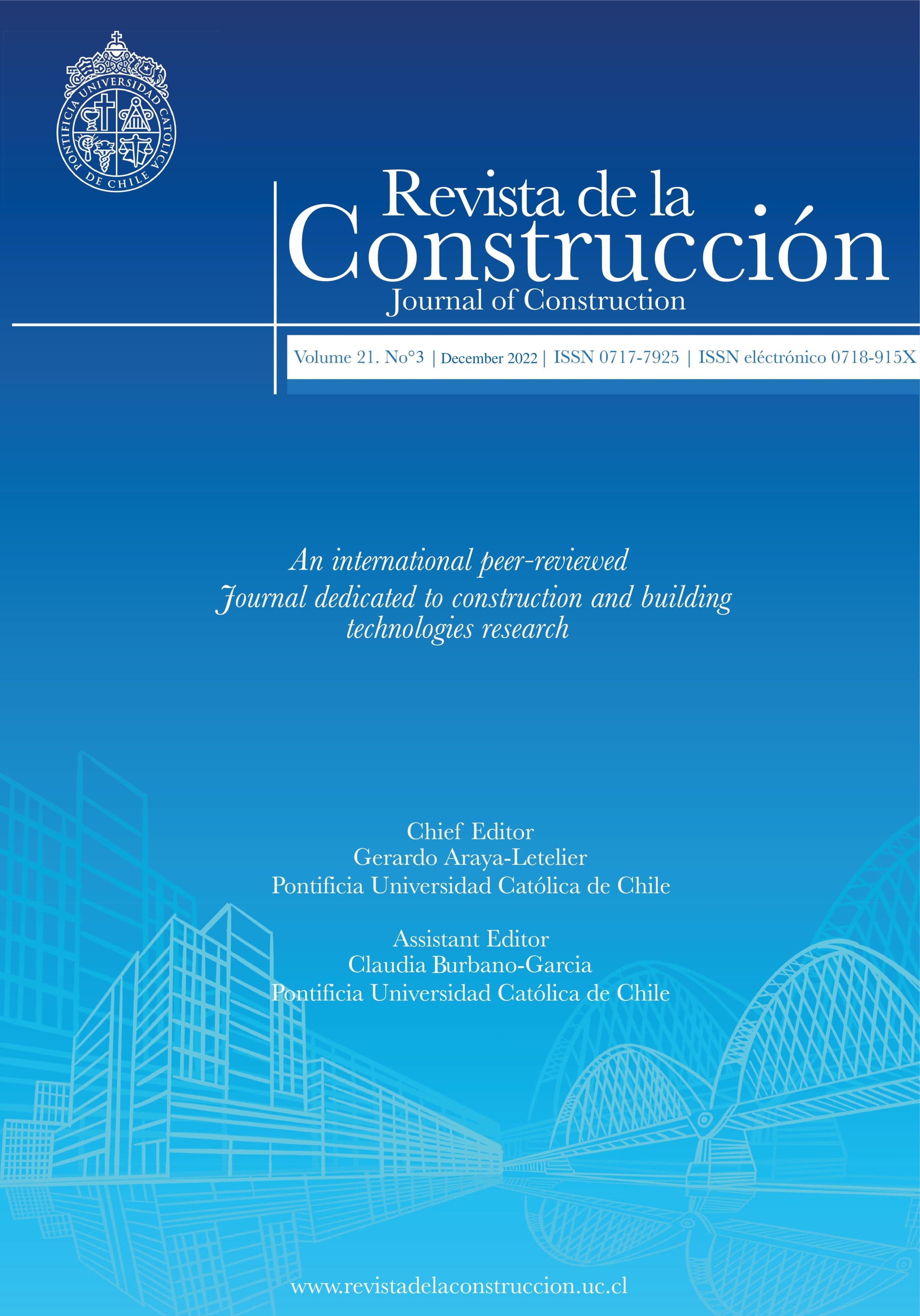Experimental and numerical dynamic identification in an RC tower
DOI:
https://doi.org/10.7764/RDLC.21.3.555Keywords:
Ambient vibration survey, operational modal analysis, tower, system identification, mode shape.Abstract
In this study, the dynamic behavior of one of the prominent structures in Istanbul, Üsküdar Observation Tower (UOT) has been investigated. The structural system of the tower is formed by a reinforced concrete circular tube having 2.8 meters outside diameter with a 40 centimeter thickness. By referring to the ground level, it starts from -18.2 meter due to five basement stories around the tower and its height is 44 meters. Two reinforced concrete floors were partially hanged over at 36 meter and 40 meter in height. The tower has an independent structural system from the ground level but a non-structural cladding assembly connects it to an adjacent building in the complex. With the mentioned structural features, Ambient Vibration Survey (AVS) was utilized to obtain the dynamic characteristics of UOT by Peak Picking (PP) method. The obtained dynamic properties were discussed with the peculiarities of UOT. While the performed analysis revealed the ineffectiveness of the adjacent building and the underground stories in the dynamic behavior of UOT, the torsion action of the floors has been noted. A numerical model has also been constructed to obtain the dynamic characteristics of UOT by Finite Element Analysis (FEA). The model calibration required to increase the code-based modulus of elasticity of the concrete by 23% for pairing the experimental and numerical dynamic properties. The reasons of the increase and the correlation between AVS and FEA were discussed.
Downloads
References
ACI 318. (2005). ACI-318, Building Code Requirements for Structural Concrete and Commentary, American Concrete Institute, Washington D.C.
Amiri, M. M. & Yahyai, M. (2013). Estimation of damping ratio of TV towers based on ambient vibration monitoring. The Structural Design of Tall and Special Buildings, (22), 862-875.
Aras, F. (2018). Modal testing of an isolated overpass bridge in its construction stages, The Baltic Journal of Road and Bridge Engineering, 13(1), 67–76.
Aras, F. & Karapınar I. S. (2021). Dynamic properties of steel structures under different construction stages, ambient temperature and live load. Revista de la Construcción, 20(1), 163-177.
Bayraktar, A., Altunişik, A. C., Sevim, B. & Türker, T. (2011). Seismic Response of a Historical Masonry Minaret using a Finite Element Model Updated with Operational Modal Testing. Journal of Vibration and Control, 17(1), 129-149.
Bayraktar, A., Türker, T., Sevim, B., Altunışık, A. C. & Yildirim, F. (2009). Modal parameter identification of Hagia Sophia bell-tower via ambient vibra-tion test. Journal of Nondestructive Evaluation, (28), 37-47.
Brincker, R., Zhang, L. & Andersen, P. (2000). Modal identification from ambient responses using frequency domain decomposition. Proceedings of the 18th International Modal Analysis Conference, San Antonio, TX, USA.
CEN (European Committee for Standardization) (2004). Eurocode 2-1: Design of concrete structures, general rules and rules for buildings. Brussels, Bel-gium.
Chen, W. H., Lua, Z. R., Lin, W., Chena, S. H., Ni, Y. Q., Xia, Y. & Liao, W. Y. (2011). Theoretical and experimental modal analysis of the Guangzhou New TV Tower. Eng Struct, (33), 3628-3646.
Consuegra, F. A. & Santos, C. (2015). Vibration analyses for the local and global evaluation of bridges as a tool for structural retrofit. Revista de la Construcción, 14(1), 16 - 22
D’Ambrisia, A., Valentina, M. & Marco, M. (2012). Seismic assessment of a historical masonry tower with nonlinear static and dynamic analyses tuned on ambient vibration tests. Eng Struct, (36), 210-219.
Ersoy, U. (2000). Reinforced Concrete, Evrim Publishing House, Ankara.
Gaylard, M. E. (2001). Identification of proportional and other sorts of damping matrices using a weighted response-integral method. Mechanical Systems and Signal Processing, 15(2), 245–256.
Gentile, C. & Saisi, A. (2007). Ambient vibration testing of historic masonry towers for structural identification and damage assessment. Const Building Mat, (21), 1311-1321.
Hökeleki, E., Nohutçu, H., Demir, A., Ercan, E. & Karabulut, A. (2020). Seismic Assessment in a Historical Masonry Minaret by Linear and Nonlinear Seismic Analyses. Periodica Polytechnica Civil Engineering, 64(2), 438–448.
Ibrahim, S. R. (1986), An approach for reducing computational requirements in modal identification. AIAA Journal, 24(10), 1725–1727.
Inman, D. J. (2013)..Engineering vibration, 4th ed., Prentice Hall, New Jersey.
Ivorra, S. & Pallarés, F. (2006). Dynamic investigations on a masonry bell tower. Eng Struct, (28), 660-667.
Li, C. & Shen, J. (2012). Analytic wavelet transformation‐based modal parameter identification from ambient responses. The Structural Design of Tall and Special Buildings, 21, 431-446.
MacGregor, J. G. & Wight, J. K. (2005). Reinforced Concrete: Mechanics And Design, Pearson, Upper Saddle River, NJ.
MATLAB (2012) [Computer software] (2012). MathWorks, Inc., Natick
Ribeiro, D., Leite, J., Pinto, N. & Calçada, R. (2019). Continuous monitoring of the dynamic behavior of a high-rise telecommunications tower. The Struc-tural Design of Tall and Special Buildings, (28), e1621.
Russo, G., Bergamo, O., Damiani, L. & Lugato, D. (2010). Experimental analysis of the ‘Saint Andrea’ Masonry Bell Tower in Venice. A new method for the determination of ‘Tower Global Young's Modulus. Eng Struct, (32), 353-360.
SAP2000 V16. (2016). Structural analysis program-integrated finite element analysis and design of structures. Analysis Reference, Berkeley, California.
Serhatoğlu, C. & Livaoğlu, R. (2019). A fast and practical approximations for fundamental period of historical Ottoman minarets. Soil Dynamics and Earthquake Engineering, (120), 320-331.
TS500 (2000) Requirements for Design and Construction of Reinforced Concrete Structures, Turkish Standard Institute, Ankara.
Vidiella, P. P., Miranda, A. R., Valle Melon, J. M. & Galarraga, A. L. (2017). Cycles and trends in the dynamics of a leaning tower. Eight years of geomet-ric monitoring with surveying techniques, Revista de la Construcción, 16(1), 158-166.
Downloads
Published
How to Cite
Issue
Section
License
Copyright (c) 2022 Fuat Aras, Tarık Tufan

This work is licensed under a Creative Commons Attribution-NonCommercial-NoDerivatives 4.0 International License.








